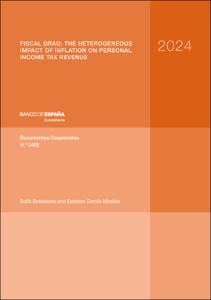Fiscal drag: the heterogeneous impact of inflation on personal income tax revenue
Authors
Issue Date
8-Aug-2024
Physical description
31 p.
Abstract
En los últimos años, la recaudación por IRPF ha mostrado un fuerte dinamismo. Una parte de este incremento se debe al crecimiento de las rentas de los hogares, mientras que otra parte se debe al efecto progresividad en frío, que da lugar a un aumento de los tipos medios efectivos cuando los parámetros del IRPF (los tramos y los beneficios fiscales) no se actualizan plenamente con la inflación. En este trabajo se utiliza una herramienta de microsimulación fiscal basada en datos administrativos de los declarantes de este impuesto para estudiar la magnitud del efecto progresividad en frío, su heterogeneidad entre declarantes, sus mecanismos y su impacto sobre la recaudación y sobre los tipos medios efectivos en el período reciente y futuro. Se estima que, en ausencia de actualización de los parámetros fiscales, un incremento homogéneo de la renta de los hogares de un 1 % ocasionaría un incremento de la recaudación de un 1,85 %, en línea con la elasticidad media estimada para los países de la Organización para la Cooperación y el Desarrollo Económicos (OCDE). Este efecto es mayor en las rentas medias y medias-altas, y produce un aumento de los tipos efectivos a lo largo de toda la distribución de declarantes, lo que provoca una reducción de la desigualdad de la renta neta. Se estima que en torno a la mitad del incremento de la ratio de IRPF sobre PIB observado entre 2019 y 2023 estaría explicada por el efecto progresividad en frío. A futuro, en ausencia de cambios en los parámetros del impuesto, la ratio de IRPF sobre PIB podría alcanzar el 9 % en 2025, un 29 % superior a su nivel en 2019.
In recent years, personal income tax collection has shown strong dynamism. Part of this increase is due to household income growth, while another part is due to the “fiscal drag” effect, which results in an increase in average effective rates when the parameters that determine the tax (brackets and tax benefits) are not fully updated with inflation. This paper uses a tax microsimulation tool based on tax filers’ administrative data to study the magnitude of the fiscal drag effect, its heterogeneity across the income distribution, its mechanisms and its impact on tax collection and on average effective tax rates in recent years and in the future. It is estimated that, in the absence of indexation of the nominally defined parameters of the tax, a homogeneous increase in household income of 1% would lead to an increase in income tax revenue of 1.85%, in line with the average elasticity estimated for OECD countries. This effect is greater for middle and upper-middle incomes and produces an increase in effective tax rates across the entire distribution of tax filers, leading to a reduction in net income inequality. It is estimated that around half of the increase in the personal income tax-to-GDP ratio observed between 2019 and 2023 can be explained by the fiscal drag effect. Going forward, in the absence of changes in tax parameters, the ratio of personal income tax revenue to GDP could reach 9% in 2025, 29% higher than its level in 2019.
In recent years, personal income tax collection has shown strong dynamism. Part of this increase is due to household income growth, while another part is due to the “fiscal drag” effect, which results in an increase in average effective rates when the parameters that determine the tax (brackets and tax benefits) are not fully updated with inflation. This paper uses a tax microsimulation tool based on tax filers’ administrative data to study the magnitude of the fiscal drag effect, its heterogeneity across the income distribution, its mechanisms and its impact on tax collection and on average effective tax rates in recent years and in the future. It is estimated that, in the absence of indexation of the nominally defined parameters of the tax, a homogeneous increase in household income of 1% would lead to an increase in income tax revenue of 1.85%, in line with the average elasticity estimated for OECD countries. This effect is greater for middle and upper-middle incomes and produces an increase in effective tax rates across the entire distribution of tax filers, leading to a reduction in net income inequality. It is estimated that around half of the increase in the personal income tax-to-GDP ratio observed between 2019 and 2023 can be explained by the fiscal drag effect. Going forward, in the absence of changes in tax parameters, the ratio of personal income tax revenue to GDP could reach 9% in 2025, 29% higher than its level in 2019.
Publish on
Documentos Ocasionales / Banco de España, 2422
Other versions
Subjects
Impuesto sobre la renta; Recaudación; Inflación; Indexación; Deflactación; Desigualdad; Personal income tax; Revenue; Inflation; Indexation; Inequality; Distribución de la renta; Impuestos y otros ingresos públicos; España
Appears in Collections:












